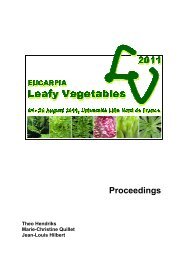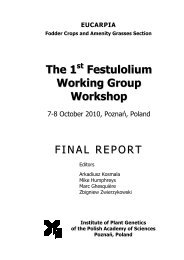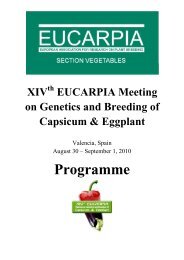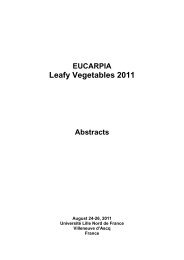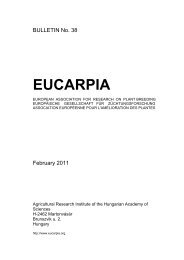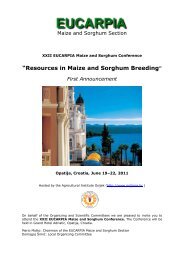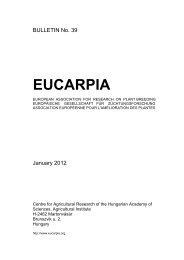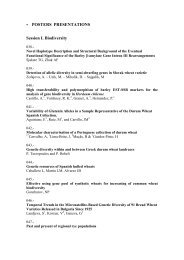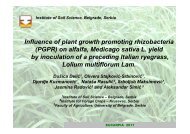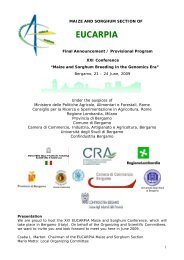Plant breeding for organic and sustainable, low-input agriculture
Plant breeding for organic and sustainable, low-input agriculture
Plant breeding for organic and sustainable, low-input agriculture
You also want an ePaper? Increase the reach of your titles
YUMPU automatically turns print PDFs into web optimized ePapers that Google loves.
The effect of the selection environment on several traits of onion (Allium cepa).<br />
M. Tiemens-Hulscher 1 , E.T. Lammerts van Bueren 1 , A. Osman 1 , R. de Heer 2<br />
1 Louis Bolk Instituut, Driebergen, The Netherl<strong>and</strong>s;<br />
2 Limagrain Advanta, Rill<strong>and</strong>, The Netherl<strong>and</strong>s<br />
The <strong>organic</strong> sector is searching <strong>for</strong> the best strategies to obtain varieties that are optimally<br />
adapted to the <strong>organic</strong> environment. For most private <strong>breeding</strong> companies the <strong>organic</strong> sector is<br />
just a small (new) niche market. For economical reasons they prefer to select under conventional<br />
conditions, with some additional evaluation criteria, <strong>and</strong> test the new lines under <strong>organic</strong><br />
conditions in the last few years of the <strong>breeding</strong> program. The subject of this study is to search<br />
whether selection under <strong>organic</strong> conditions gains better adapted varieties <strong>for</strong> the <strong>organic</strong> sector,<br />
than selection under conventional conditions. Together with a Dutch onion <strong>breeding</strong> company<br />
we investigated the effects of the two different selection environments from 2004-2007.<br />
To compare the selection progress under conventional <strong>and</strong> <strong>organic</strong> conditions selection in the<br />
open pollinated variety Bastora <strong>and</strong> two broad, newly made, base populations of onion was<br />
conducted: Round Rijnsburger Group, <strong>and</strong> the Yel<strong>low</strong> Flat Rijnsburger Group, from 2004-2007.<br />
St<strong>and</strong>ardized Selection Differential (S) was determined as a measure <strong>for</strong> selection ef<strong>for</strong>t. S =<br />
(mean new selection – mean original population)/sedor whereas sedor is the st<strong>and</strong>ard deviation of<br />
the original population. Seeds were produced from the selected bulbs in isolation cages. The new<br />
selections (<strong>organic</strong> <strong>and</strong> conventional) were sown at two <strong>organic</strong> locations in three replicates<br />
together with the original populations to compare with each other in the field <strong>for</strong> plant traits as<br />
well as <strong>for</strong> bulb characteristics after storage. Response to selection (R) was determined (R =<br />
mean selection – mean original population).<br />
2007: in an additional pilot experiment the potential rooting ability of the bulbs was evaluated by<br />
growing the bulbs in hydro-culture <strong>for</strong> 2½ weeks.<br />
Most selection ef<strong>for</strong>t (S) was made <strong>for</strong> the traits bulb shape <strong>and</strong> bulb size, independently of the<br />
selection environment. Although, the selection criteria of the breeder were the same <strong>for</strong> both<br />
selection environments, S differed <strong>for</strong> some traits between the <strong>organic</strong> <strong>and</strong> the conventional<br />
selections. In the populations grown in the <strong>organic</strong> field S was zero <strong>for</strong> the position of maximum<br />
diameter, the number of dry skins, the shape of the base of the onion <strong>and</strong> the intensity of basic<br />
colour of dry skin. For the conventional selections no selection ef<strong>for</strong>t was found <strong>for</strong> skin<br />
retention. For the other traits S was more or less the same <strong>for</strong> the <strong>organic</strong> <strong>and</strong> the conventional<br />
selections. For the traits earliness <strong>and</strong> root potential the Response to selection (R) was affected<br />
by the selection environment. The conventional selection of Balstora was much earlier than the<br />
<strong>organic</strong> one. In the root experiment we found a striking difference between the <strong>organic</strong> <strong>and</strong> the<br />
conventional selection in the Yel<strong>low</strong> Flat Rijnsburger Group. The bulbs of the <strong>organic</strong> selection<br />
<strong>for</strong>med proximately 60% more roots (number <strong>and</strong> dry weight) than the conventional selection. In<br />
the other populations we did not find this phenomenon. For the other traits R was not affected by<br />
the selection environment, although S was found different <strong>for</strong> the respective characteristics.<br />
64




